AKG C414 XLII
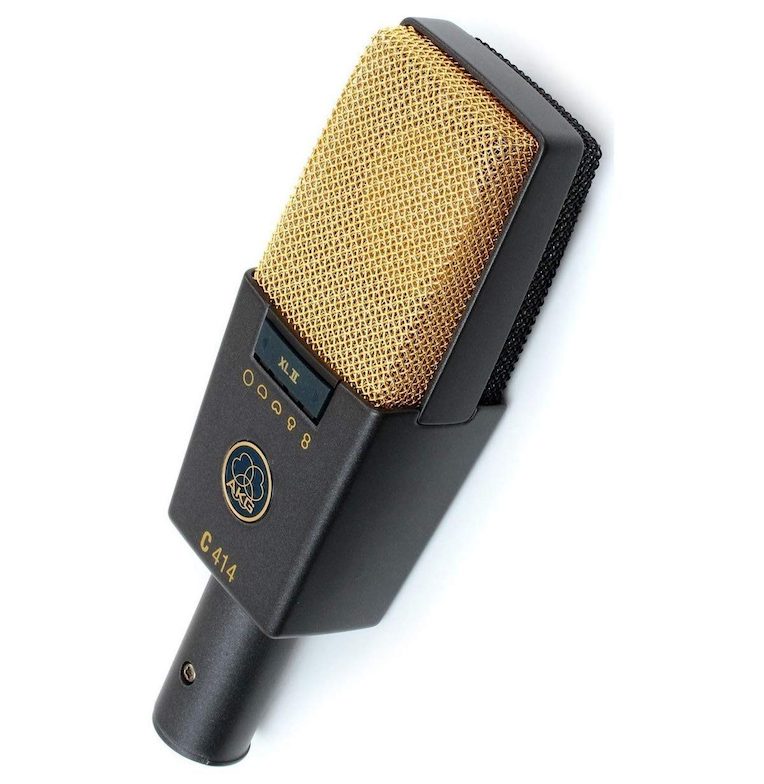
The AKG C414 Condenser Microphone
The AKG C414 condenser microphone is sold today in two versions, the AKG C414 XLII and the AKG C414 XLS. In this article, we review the AKG C414XLII(see current price) and cover the difference between these two microphone versions. Which version of the C414 is best for you? What makes the C414 so popular? Let’s go ahead and dive into the C414.
AKG’s C414 is one of the most popular and widely used microphones in the world today. You’re likely to see one in every major studio. It has become a professional studio standard (although probably not to the level of the Shure SM57). However, the C414 didn’t make its name overnight. The C414 has had a long path and climb to the top. And its evolution is legendary in the audio world.
History of the C414
AKG is one of the most respected brands in audio today. Founded in 1947, in Vienna, Austria, the first AKG microphones were quick to make a splash on the scene. Manufactured by hand, with only five workers at the time, the popularity of these microphones quickly spread across the region. Within months they could be seen in major radio stations, theaters, and jazz-clubs across the world.
AKG continued its early momentum. Developing new products, AKG released their famous tube condenser microphone, the AKG C12, in 1953. The high-quality brass capsule of the C12, the CK12, became regarded as one of the finest capsules in audio.
This capsule propelled the hugely popular C12 microphone, that also allowed you the unique ability to switch between polar patterns. The C12 would lead to a gradual evolution of new models from AKG, that would eventually result in today’s iteration of the AKG C414.
The Legendary C414
However, the first true model of the C414 was released by AKG in 1976, the legendary C414 EB. The C414 EB became highly renowned for its brilliant high-end. Using the same brass capsule from the C12, it outshined competitors with its clarity and highly detailed treble response. The high-end clarity and the ability to cycle through polar patterns with the click of a button on the front of the microphone, made the C414 EB a powerful and versatile weapon in the studio.
The C414 EB found great success and became a top microphone choice in the recording world. Adopted by Queen’s Freddie Mercury in the 1970s, used often by Paul McCartney, used in The Police’s Every Breath You Take, seen on the desk of The Tonight Show’s Johnny Carson, used by Luther Vandross, Hall & Oates, used in Sinead O’Connor’s Nothing Compares 2 U, and also Coldplay’s Chris Martin’s favorite microphone, the C414 became legendary.
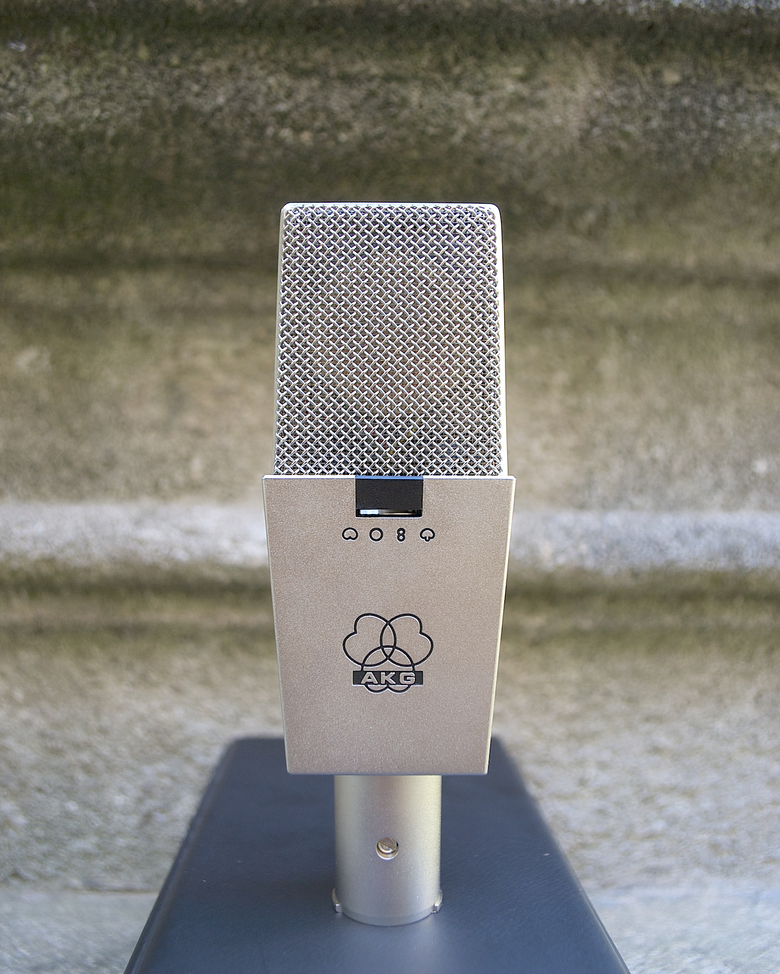
Evolution
However, it was the particular C414 “EB” that was the desirable favorite. AKG continued to evolve the C414 throughout the 1980s and 90s. They released several new iterations of the C414 including the EB-P48 (1980), B-ULS (1986) and B-TLlI (1993). With each new model, significant tweaks were made that were both celebrated and criticized (but mostly criticized). The consensus was that the later C414s were simply not as good as the original C414 EB.
Perhaps the preference for the EB is simply a nostalgic “good-old-days” bias. Or, maybe it’s completely warranted. Nonetheless, it’s clear that the later C414s were indeed different both in sound and design. AKG’s shift from the lustrous brass capsule of the CK12 to a new nylon version which was cheaper to manufacture (the tale of many failed evolutions in the audio history) resulted in a dramatic shift in sound. The later C414s struggled to maintain the same shimmering high-end and brilliant sound character that the C414 EB became renowned for.
Although many believed the newer C414s had a darker sound, the shift to the nylon capsule also resulted in a more neutral sound which worked better for many other recording sources. A taste was developed for the darker and more neutral sound, arguably making the later C414s more versatile than the EB. Nonetheless, many still prefer the legendary character of the C414 EB. When you know a piece of audio gear is legendary, it suspiciously tends to sound better to most people, every time.
Although changes to the C414 were criticized, the newer C414s also underwent other significant improvements. They became quieter, with less self-noise and higher output. There were also significant build and design improvements, resulting in fewer pops and sound artifacts and increased durability, not to mention the shiny gold grille that emerged.
The Modern C414
Finally, in 2004, AKG decided to divide the C414 into two lines, releasing the C414B-XLII and the C414B-XLS. There had been confusion over the years about the sound character of the C414, as it seemed to fluctuate between dark and bright sporadically with each new model. Over the years, owners of the C414 had developed particular tastes for either the brighter or darker tonality. This split helped ease confusion in their marketing. Simply put, the B-XLII became the brighter microphone and the B-XLS, the darker one.
Five years later and shortly after AKG celebrated their 60th anniversary, AKG dropped the B from the XLII and XLS, releasing their latest models, the C414 XLII and C414 XLS. The most significant improvement with these latest models was the upgrade from five polar patterns to the addition of four more polar patterns (in between each pattern) to switch through. With this addition, the XLII and XLS have become the most versatile models of the C414 to date. We’ve chosen to review the more popular of the two models, and this is where our C414 XLII review begins.
AKG C414 XLII Review
C414 Review: Build and Quality
The AKG C414 XLII and XLS keep the classic shape that its predecessors have become famous for. The appearance of the C414 begins with its compact, somewhat box-shaped design. Although the design is basic, the beautiful gold grille found on the C414 XLII, makes this microphone appear quite flashy when in the studio. You shouldn’t judge a microphone by its look. However, if you’re running a small startup studio, the impression of your clients and collaborators seeing the sparkling C414 can be a valuable thing.
The base of the C414 is solid and heavy, quite frankly, it’s built like a tank. This, however, is not true for the mesh screen gold grille of the C414. Although pleasing to the eye, it is clear that it is quite fragile. Feedback from owners of the C414 indicates the same. The grille is prone to dents and bends if you are not careful with your handling of the C414.
The greatest danger of this is not simply scarring the look of your C414, however. Underneath that grille is the precious heart of the C414, the 2nd generation CK12 nylon capsule, responsible for the sound of the C414. Although with newer models, AKG has since implemented an elastic mounting around its capsule to minimize vibration and potentially damaging force the capsule may experience, the capsule is still too precious to be careless. Simply put, be careful to never drop this microphone. Although it may survive a few drops, it’s no Shure SM57 or SM58 (invincible workhorses).
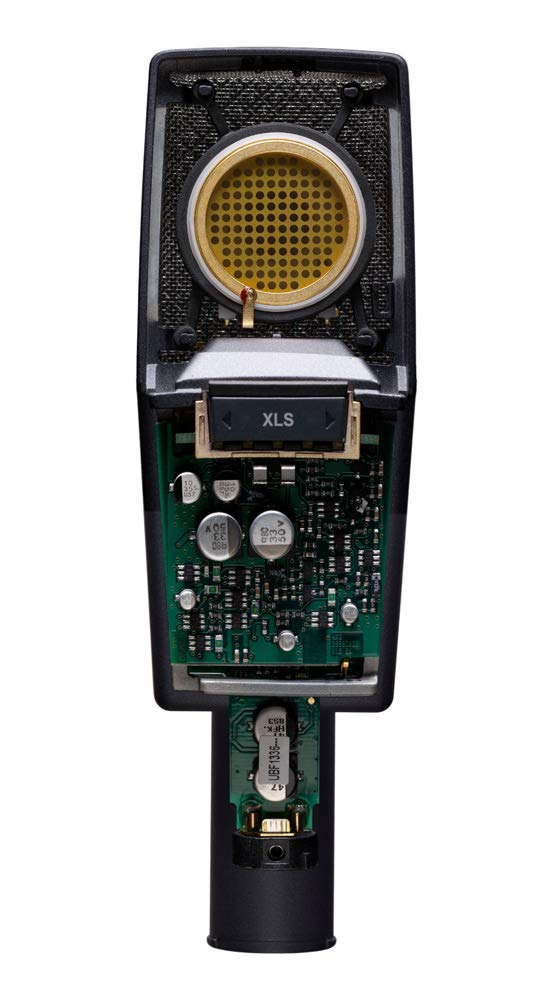
Front Controls
Below its beautiful gold grille, on the front panel, is a nine pickup pattern selectable switch. With the click of a button, you can switch between five primary polar patterns or use four hybrid patterns between each of these five. Underneath this switch is an LED light strip allows you to see which pattern is selected.
The LED strip also has a very handy feature of detecting peak overloads and clipping. The LED will switch from green to red even when the faintest distortion from clipping occurs, allowing you to adjust your levels as needed. This is especially useful if you’re recording an extremely loud source such as drums or blaring guitar amps.
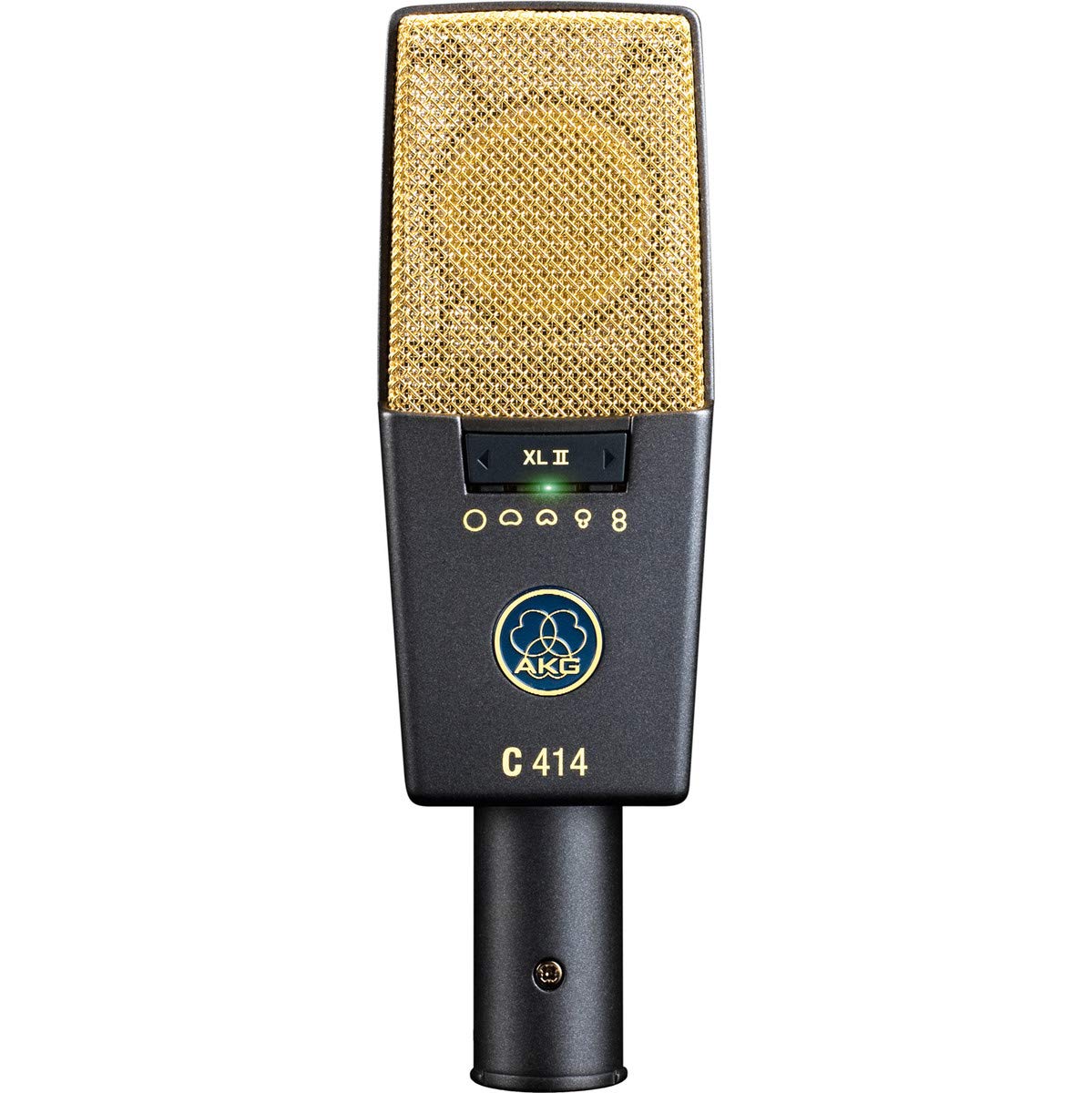
The 5 primary polar patterns you can select on the C414 are:
- Omnidirectional – Great for capturing moving sounds, including the sound of a room.
- Wide-cardioid – Used for capturing wider sound sources in a specific direction, such as a live band or choir.
- Cardioid – The standard for recording vocals and most instruments.
- Hypercardioid – Great for further isolation, tight sound sources, blocking out noises from the side.
- Figure-8 – Used in stereo recording, great for two vocalists or M/S recording.
It is with this option to switch between polar patterns, that takes the C414 from just being a crisp sounding microphone to an invaluable recording solution for recording across many different scenarios. And this may be the biggest reason why the C414 has become a microphone found in just about every major studio.
Whether you’re looking to do mid-side recording by pairing up the C414’s figure-8 pattern with a cardioid microphone or want to capture an entire room of sound with the omnidirectional (all-directions) pattern, the C414 can be an invaluable tool for nearly every recording scenario.
The C414 also has a handy lock mode feature for its polar pattern selector. This is useful if you want to stay on the polar pattern you selected to prevent accidental switches. By holding down one of the arrows on the selector for around 2 seconds, you’ll enable lock mode. A red LED will briefly light up when you try to switch patterns, indicating that you are in lock mode and unable to switch patterns. You can disable lock mode by holding down one of the arrows for another 2 seconds. This is also useful if you’re going to only have one use for the AKG C414, such as simple vocal recording. In this case, you could enter lock mode while on the cardioid pattern, and won’t have to bother with the pattern selector or worry about it in the future.
Rear Controls
On the rear of the C414, you’ll find two switches with LED lights underneath. On the left, the C414 has a pre-attenuation pad allowing you to select between 4 pre-attenuation settings (0 dB, -6 dB, -12 dB, -18 dB). This is another perk that widens the usefulness of the C414, allowing you to make adjustments as needed depending on the loudness of your recording source. Combined with the clipping indicator on the front of the C414, you have the ability to quickly detect distortion in your signal and pad your signal, creating more headroom as needed.
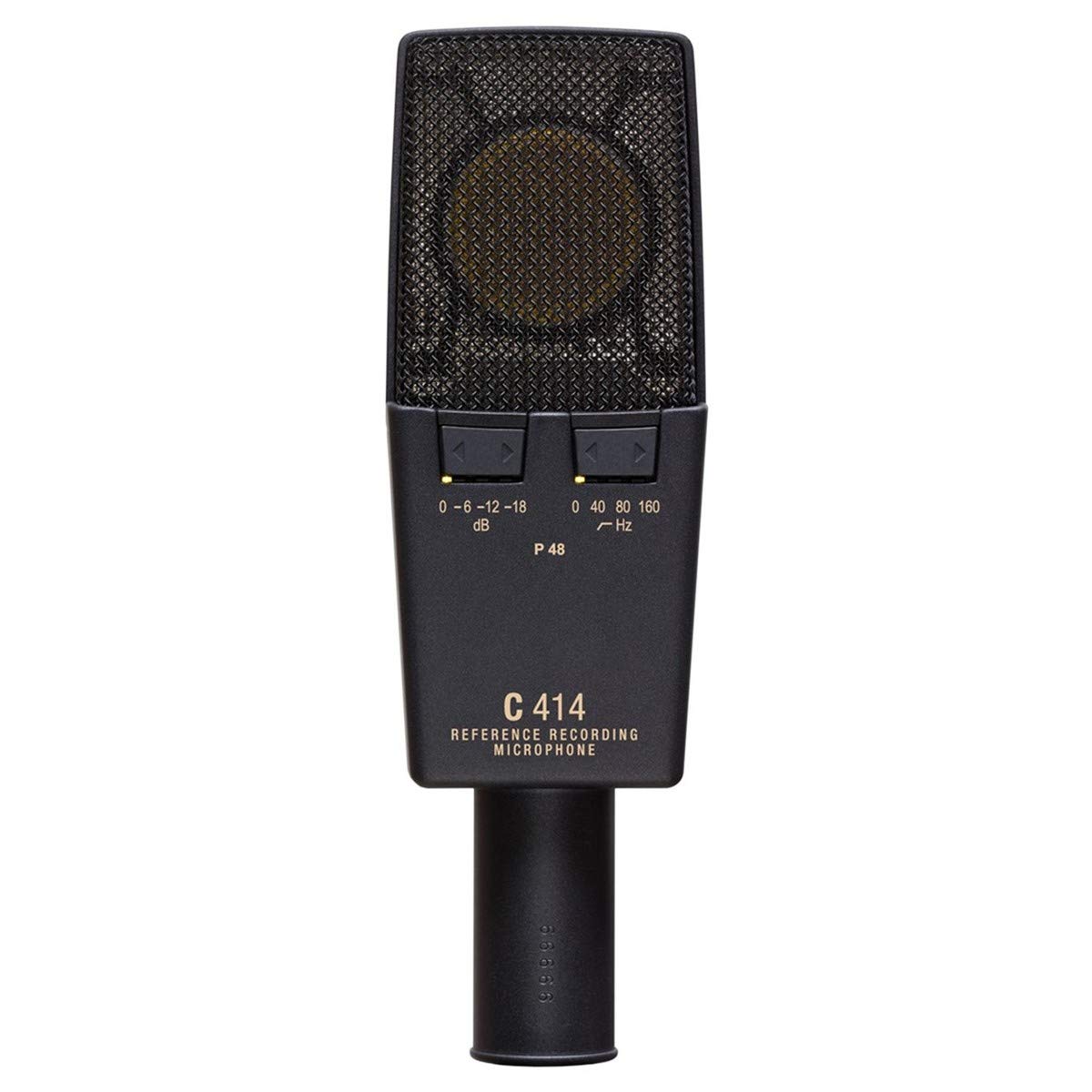
On the rear panel’s right side, the C414 has a low cut filter. You can toggle between 0, 40, 80 and 160hz, allowing you to roll-off unnecessary low end in your recording signal. This can also be useful in scenarios where your recording source is too boomy, or to help battle an undesirable proximity effect.
Review: Sound Quality
The ability to switch between polar patterns on the C414 is what makes it so incredibly useful, but it is the sound quality and character of this microphone which ultimately seals the deal. The C414 has become renowned for its high-end clarity and sound character. This is what makes the C414 XLII (which has more high-end than the XLS to suit vocals) particularly popular as a vocal microphone.
The C414 has shimmering treble frequencies, a very polished and detailed sound which stresses clarity. This makes the C414 a great option for highly detailed and textured instruments, such as drums, acoustic guitar, biting electric guitars, and of course, vocals.
Some Coloration
Despite the clarity and detail, there is also some considerable coloration with this microphone. The C414 XLII has a slight scoop in its cardioid pattern between 1-2khz and is boosted around 5khz. This is seemingly to enhance the perception of clarity and space, and bring out the high-end presence of a vocal. The C414 also rolls off some frequencies around 6-7khz, this can create a positive de-essing effect and reduce sibilance in singing. Although, this may help to smoothen out the vocal, some would prefer a less colored signal, a more neutral sound that can be shaped as needed during mixing.
The C414 has very little self-noise and sounds very clean. AKG claims that the C414 is “immune to electrostatic and electromagnetic interference”. However, the C414 can be quite prone to the proximity effect. Due to the sensitivity of its capsule, you’re going to experience a lot of boominess if recording vocals too close to this microphone. This can be a valid concern when recording quiet vocals.
Room Matters
Also, this is where something very important to consider comes into play. Because you want to prevent the boomy proximity effect of recording too close to the C414, you’ll need to back up from it. However, as you back up from the C414, you’ll need to raise your levels at some point to bring out the same amount of loudness in your recording. The problem with this is that you’ll be capturing more room noise. And if you haven’t got a properly treated room to record in, the C414 may not be the best choice for you.
This is an issue you’ll experience with all condenser microphones. This is why we actually recommend dynamic microphones over condenser microphones for beginners with untreated rooms. However, the C414 seems especially affected by this due to its high sensitivity. In other words, the great accurate and detailed sound that the C414 captures, can also be a disadvantage, exposing the flaws of your room and exacerbating the ugly effects of poor recording techniques.
Nonetheless, the AKG C414 has a great sound. It just requires a little more diligence while recording. This is not a criticism of the C414, but certainly something to consider if you have yet to properly treat your room.
XLII & XLS Specs:
- Frequency Response: 20Hz-20kHz
- Sensitivity: 23 mV/Pa
- Signal to Noise Ratio: 88dB-A
- Self Noise: 6dB-A
- Max SPL: 140dB (or 158dB w/18dB Pad)
- Output Impedance: 200 ohms
- Recommended load impedance: 2200 Ohms
- 48v Phantom Power Required: Yes
- Output Type: Balanced XLR
- Height: 1.5 in / 38 mm
- Width: 1.97 in / 50 mm
- Length: 6.3 in / 160 mm
- Weight: .66 lbs / 300g
XLII vs XLS
So, what’s the difference between the C414 XLII and XLS? The XLII and XLS are indeed very similar microphones. They look nearly identical with the exception being that the XLII has a gold grille and the XLS has a silver grille. Although it’s a matter of taste, this seems to result in the XLII being a flashier and more attractive microphone visually.
The real distinction is the slight difference in sound character between these two microphones. Simply put, AKG has designed the XLII to be more suitable for vocals and the XLS to be more suitable for instruments. So, what’s the specific difference in sound? The only real difference is that the XLII has a slight boost on its top end. This subtle boost brightens up vocals and makes them shine a little more on the XLII than on the XLS.
The XLS has a more neutral sound. In comparison, the XLS is darker than the XLII. Due to the more neutral sound from the XLS, it is suitable for a wider variety of applications than the XLII. The XLII can even seem somewhat harsh or abrasive to some when compared to the XLS, although this is a matter of taste.
Should you buy the XLII or the XLS?
If your main purpose for buying the AKG C414 is to record vocals, we’d recommend going with the XLII. Although subtle, the slight treble boost can bring out some extra clarity and presence to vocals.
When it comes to price, the XLII(see current price) tends to be around $100-200 cheaper than the XLS(see current price). It’s not clear why, since these microphones are so similar in design. Perhaps, it’s a matter of marketing? Nonetheless, if your main priority is recording vocals and not instruments, the price is another reason to go with the XLII.
If money is not an issue, and you truly want an all-around microphone, go with the XLS. Vocals will still sound great on the XLS. In fact, you might even have a preferred taste for its warmer sound. Overall, we believe the XLS is a slightly better microphone due to its more neutral sound, but the difference is subtle. We encourage you to look at your situation and what you want to record to decide which C414 is best for you.
What’s included?
To our surprise, the C414 actually comes in a quality case. The heavy duty aluminum case is rather large and includes a variety of accessories. Inside, along with the C414 microphone, you’ll find a nice carrying pouch with the AKG logo on it, a foam windscreen, a shock-mount, a stand-mount, and a pop filter. The included manual also shows all the frequency responses of the various polar patterns for your use.
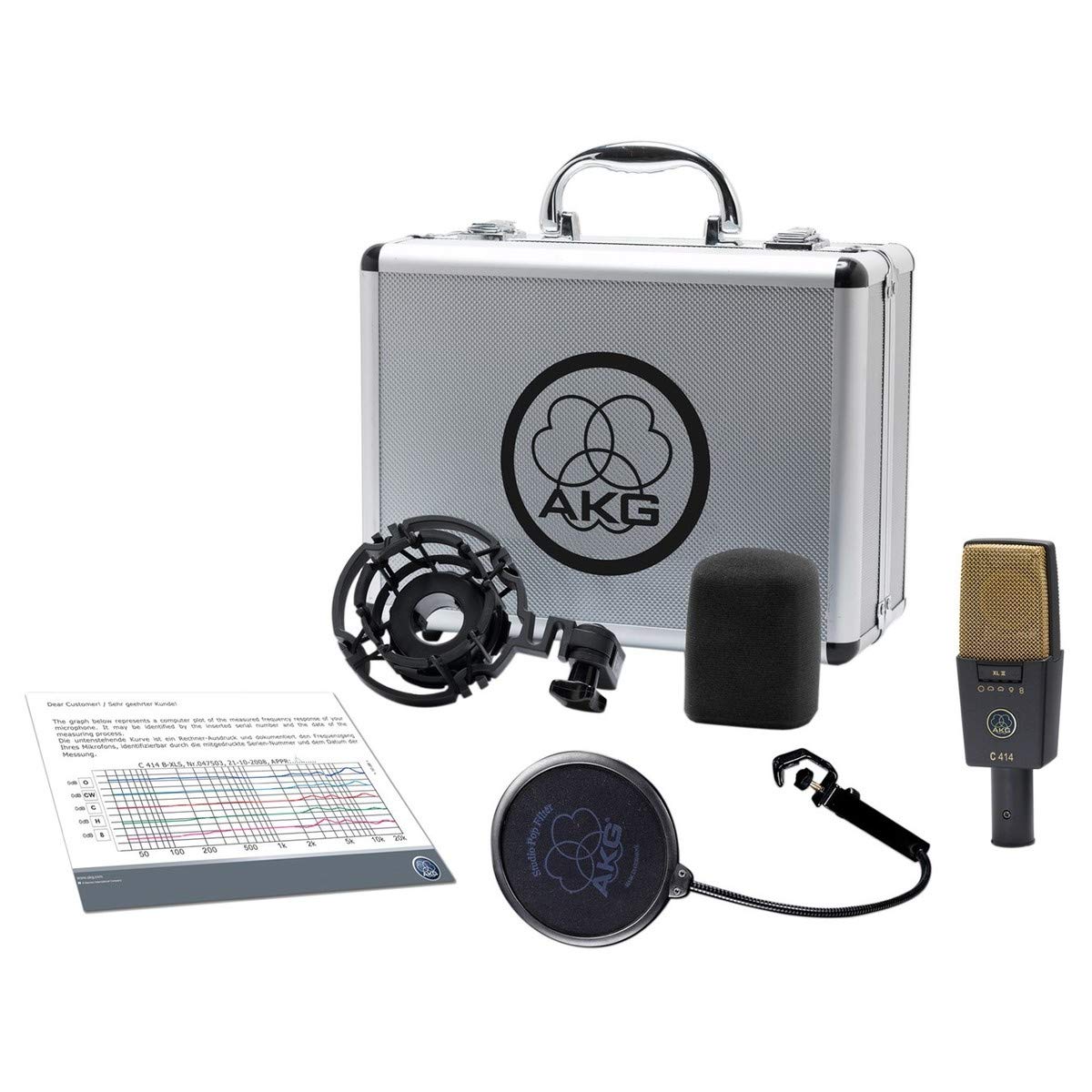
The gem of the included accessories is certainly AKG’s signature shock-mount, though. The shock-mount securely holds your microphone with one quick twist on the bottom. You simply put your mic in, twist the bottom and your microphone is locked in and secure. This makes it incredibly easy to rotate the position of your microphone. Because your microphone is secure, you can feel confident putting your microphone in any position including upside down. Quite frankly, it may be the best-designed shock-mount we’ve ever used.
Stereo Pair?
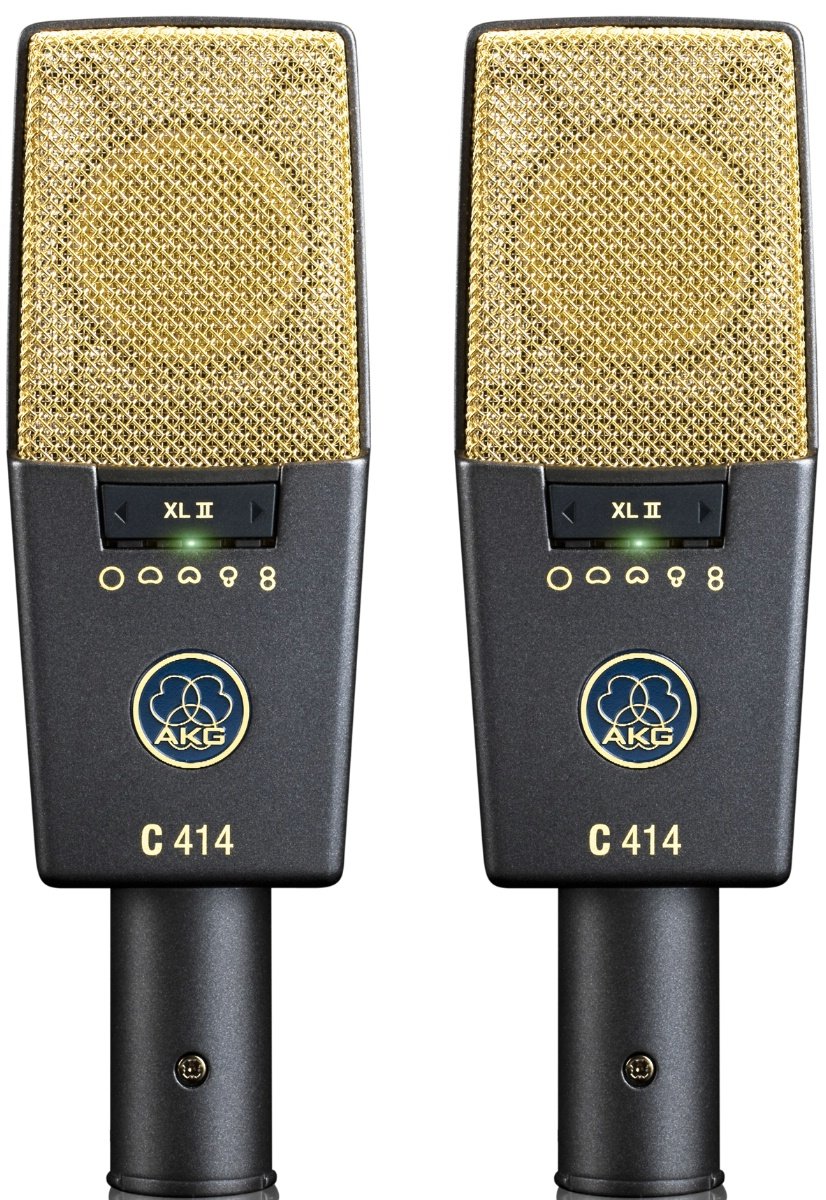
The C414 can also be bought in matched stereo pairs. Stereo pairs are available for both the XLII and XLS. This microphone has become very popular in stereo recording. The stereo pair enables you to record in a multitude of configurations whether it be X-Y, mid-side, or spaced stereo recording. Two C414s to record overhead drums is a classic setup used by many drummers. With a stereo pair and the ability to cycle between polar patterns, two C414s can be a very powerful weapon in the studio.
Who Should Buy the C414?
If you’re an amateur producer who is looking to upgrade from a budget microphone to a professional-standard high-quality condenser microphone, the C414 is a great choice. If you’re instead an established producer or recording engineer, you’ll also want to have the C414 in your arsenal. It has become a studio standard and will be quite valuable due to its versatility in the studio.
The C414 is indeed quite expensive. If it did not have the ability to switch polar patterns, then you could argue that it was too expensive. You could also argue that there are other microphones at its price-point that possibly sound better. The Neumann TLM 103 is a great example of a condenser microphone in the same price range that you could say outshines the C414 in terms of sound quality.
However, this may be comparing apples to oranges. Because you are limited to the standard cardioid polar pattern with the TLM 103, the C414 is a much better choice if you’re looking for a microphone that you can use in many various recording situations. AKG’s C414 is far more versatile than Neumann’s TLM 103.
Consider Your Room
But, if your room is not yet treated, don’t bother with the C414. The C414 is a very sensitive and detailed microphone. If you have the right environment, it’s going to sound great. If you have an ugly sounding room, then you’re going to definitely hear it in your recording. This is especially true since you don’t want to record too close to the C414 due to its sensitivity to the proximity effect. Because of this, you’ll likely increase your mics gain to compensate and hence, capture more external noise.
The exception is if you WANT to capture your room’s sound. If you want to experiment with recording guitar amps and drums and capture the reverberation and ambience of a room, then go for the C414. Switching to the omnidirectional pickup pattern might even come in handy for this. Keep this in mind, and as previously stressed, buy the XLS if your focus is not on recording vocals, and the XLII if it is.
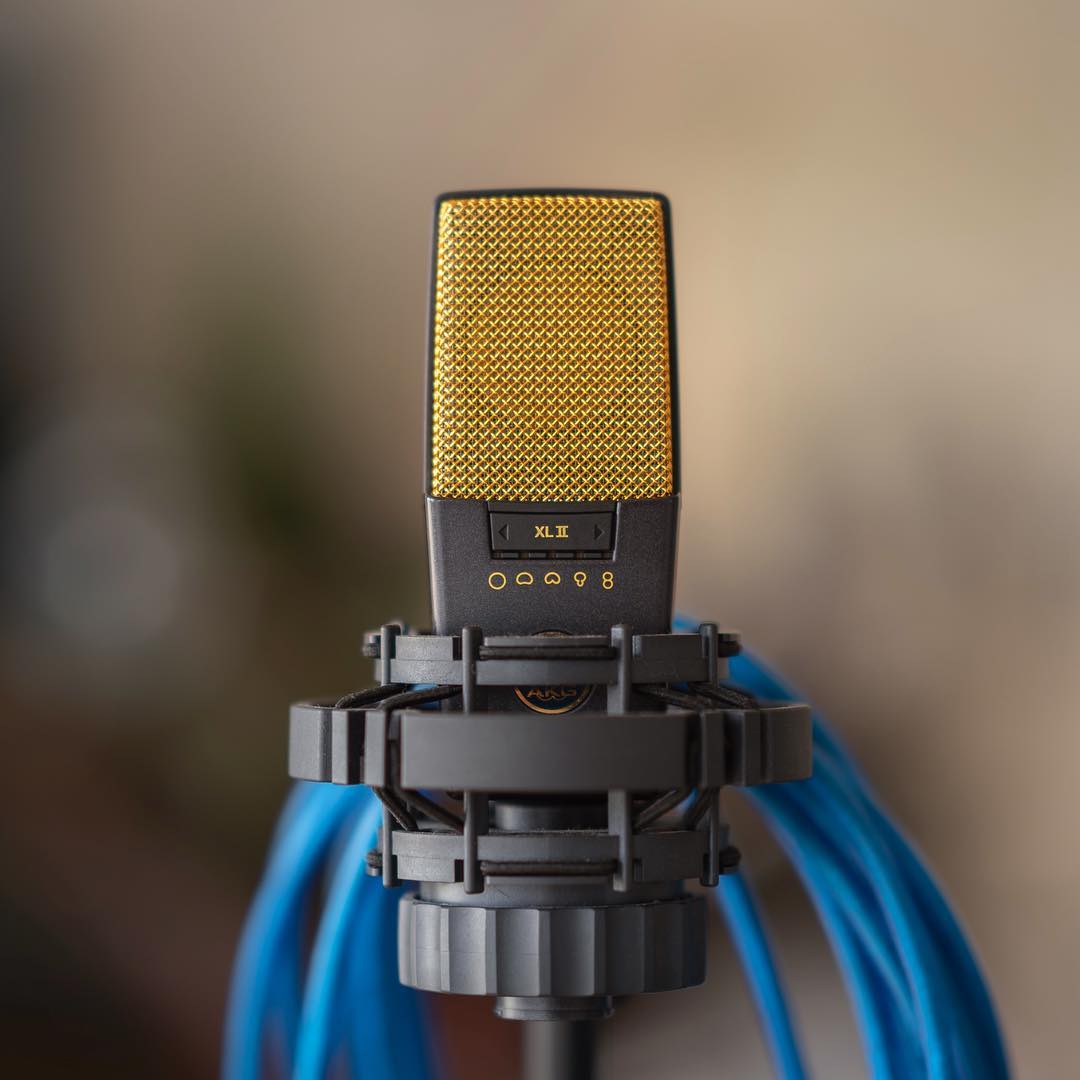
AKG C414 XLII Review: Conclusion
To wrap up this review, the AKG C414 XLII is a great all-around microphone. You’ll want a well-treated room for recording vocals and will have fantastic results with care. At worse, its critics say that it can sound harsh or abrasive at times (something you’ll want to note if you prefer a darker and warmer sound). Nonetheless, using the C414 will result in a very detailed recording despite some mindful coloration from the XLII.
Just as importantly, owning the AKG C414 is going to give you the power to recording in many various recording scenarios due to its versatile polar pattern selector. This has led to some calling it the “swiss-army knife of condensers” for this versatility.
In all, we definitely recommend this microphone if you’re looking for a high-quality all-around condenser for your treated studio, and the XLII, particularly for vocals. We hope you’ve enjoyed reading our AKG C414 XLII review, happy producing.
What are your thoughts? Feel free to let us know in a comment below or reach us on our Twitter or our Instagram.


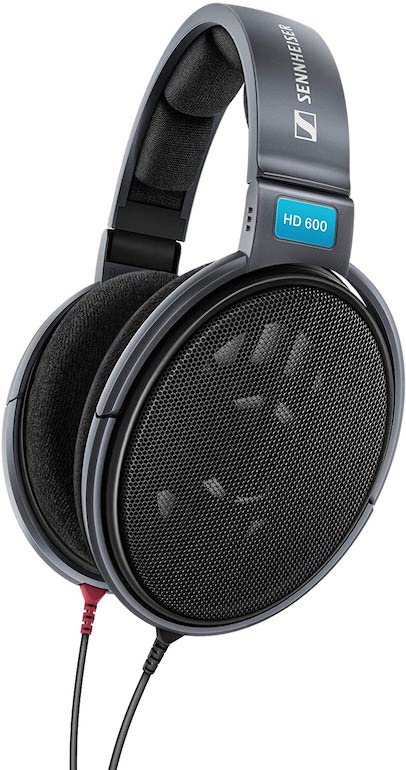

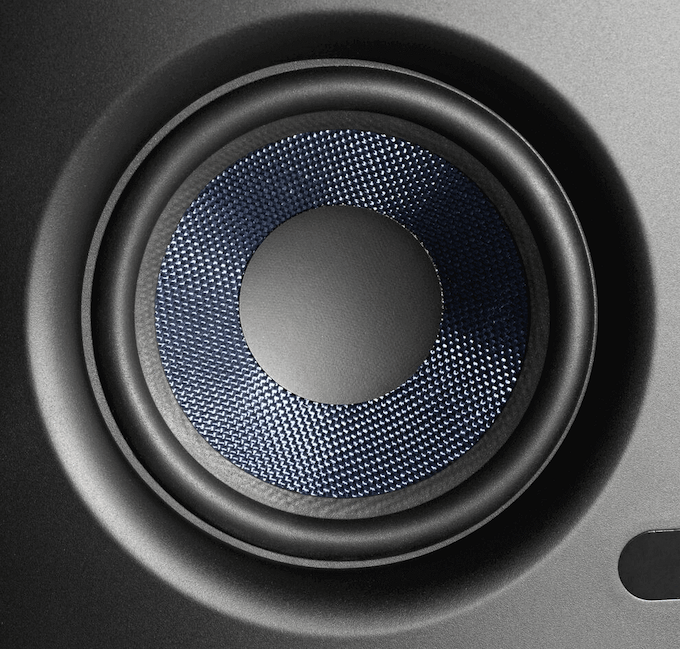



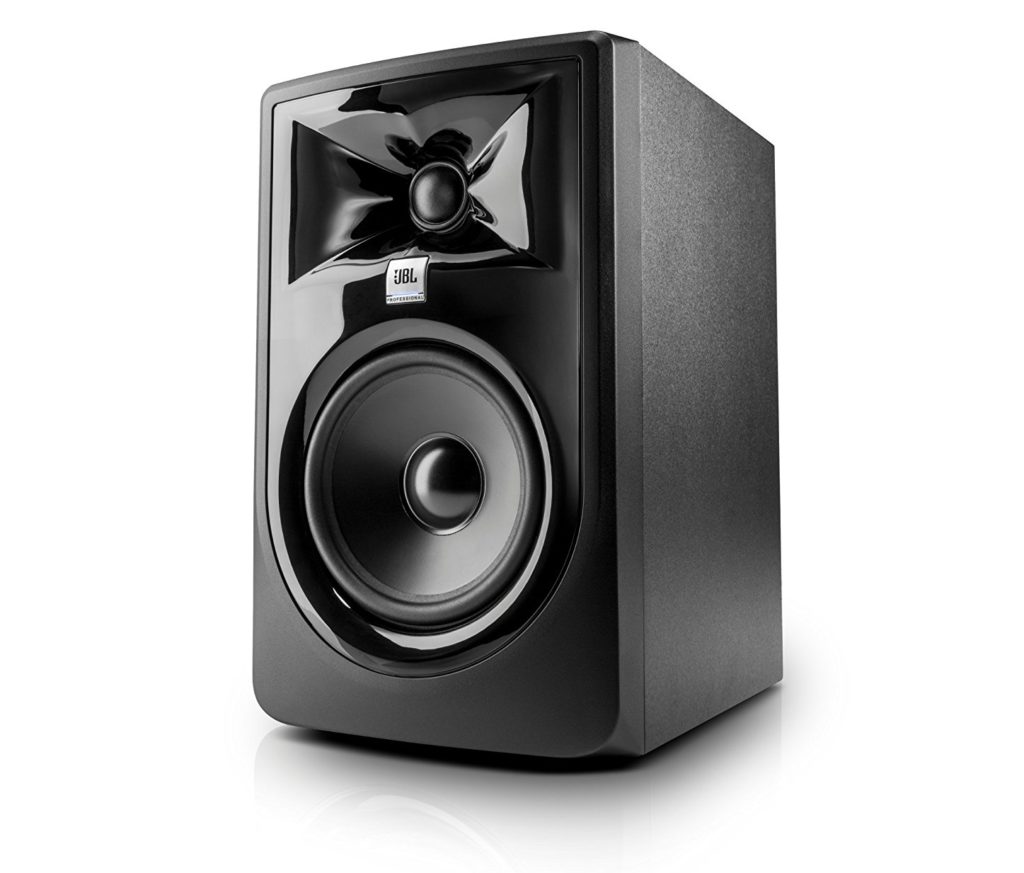










[…] microphones are not, but what about multi-pattern microphones? Some microphones like the AKG C414 or Neumann U87, allow you to cycle between multiple polar patterns, including cardioid and […]
[…] output. AKG learned from feedback over the years, culminating in their most recent C414, the AKG C414 XLII & […]
[…] with the WA-87 and WA-14, modern reproductions of the legendary Neumann U87 and AKG C414, Warm Audio has not skimped on quality. The classic U47 sound from the WA-47 is not only fitting […]
I have enjoyed reading this article / critique.
I would like to ask you, which AKG microphone do you recommend for recording voice-overs, commercials, and radio announcing in general? I have a bassy voice and could probably use some help on the high end.
Thank you for your time and consideration.
Sincerely,
Bill
Hey Bill, great question.
I would actually recommend not going with AKG if you need a microphone specifically for voice-overs. That is because AKG’s main focus is on condenser microphones, and you’ll likely want a dynamic microphone for your needs. With a dynamic microphone, you can take advantage of the proximity effect and get that nice powerful broadcast sound while minimizing ambient noise. Condensers are very sensitive to plosives and pops and generally require a greater control of your room.
Since you already have a bassy voice, I would recommend the Electro-Voice RE-20. This microphone has great high-end response and its Variable-D design minimizes excess proximity effect (useful since your voice is already bassy). It is commonly seen in radio, and is often considered a broadcast industry standard. You can check it out with this link: https://amzn.to/2qQmQl9
[…] AKG C414 […]
Does anyone else experience this mic needing a lot of extra gain? My level is set to plus ten and my gain to the 3’0clock position when I use it for online voice lessons through my mixer/audio interface which is a ProFX 10v3.
[…] Audio Gearz […]
[…] AKG C414: A versatile large-diaphragm condenser used for many different applications. […]